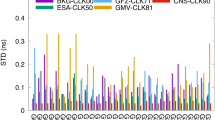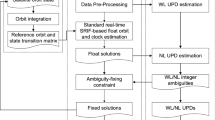Abstract
Real-time precise satellite clock estimation is fundamental for real-time precise point positioning. To take full advantage of the triple-frequency (TF) signal of the BeiDou Navigation Satellite System (BDS), we used undifferenced observations directly in the TF data processing. In addition, TF ambiguity resolution (AR) was performed in a sequential manner, in which the wide-lane (WL) and extra wide-lane (EWL) ambiguities were fixed based on the Hatch–Melbourne–Wübbena (HMW) combination of B1/B2 and B1/B3, and then we followed with narrow-lane (NL) ambiguity fixing. By applying the ambiguity integer constraints, an ambiguity-fixed BDS satellite clock was obtained. To evaluate the contribution of TF AR in a satellite clock solution when a regional station network is involved, experiments were carried out based on the observations collected by 11 stations from the crustal movement observation network of China (CMONOC) during day of year (DOY) 153–188, 2016. First, the temporal behavior of the BDS EWL and WL uncalibrated phase delays (UPDs) were analyzed. The results suggested that they were quite stable over several days with standard deviations (STDs) of 0.004 cycles and 0.015 cycles for EWL and WL, respectively. Then, the ambiguity-fixed solution of the satellite clock was obtained with average success rates of about 99%, 90%, and 63% for EWL, WL, and NL AR, respectively. Attributed to the efficient AR, not only was the initialization time shortened but also the precision was improved. The overall averaged improvements of STD for geostationary orbits (GEO), inclined geostationary orbits (IGSO), and medium-altitude Earth orbit (MEO) satellites were 48.7%, 40.8%, and 34.4%, respectively, for the EWL and WL ambiguity-fixed solution and 72.6%, 71.0%, and 62.8%, respectively, for the NL ambiguity-fixed solution. As a comparison, a dual-frequency (DF) ambiguity-fixed satellite clock was also generated. Although the precision of the NL ambiguity-fixed clock was roughly the same, a larger root mean square (RMS) by a factor of 52% suggested that the DF ambiguity-fixed solution may have been biased with incorrect integer ambiguity fixing, whereas the TF ambiguity-fixed solution was more reliable because of the third frequency observation. In addition, precise point positioning (PPP) was carried out to assess the performance of these clock products. Compared with the PPP based on the ambiguity-float clock solution, improvements of 32.0% and 42.9% for horizontal and vertical, respectively, were obtained with the TF NL ambiguity-fixed clock solution.








Similar content being viewed by others
References
Bock H, Dach R, Jaeggi A, Beutler G (2009) High-rate GPS clock corrections from CODE: support of 1 Hz applications. J Geod 83(11):1083–1094
Feng Y (2008) GNSS three carrier ambiguity resolution using ionosphere-reduced virtual signals. J Geod 82(12):847–862
Ge M, Chen J, Douša J, Gendt G, Wickert J (2011) A computationally efficient approach for estimating high-rate satellite clock corrections in realtime. GPS Solut 16(1):9–17
Geng J, Shi C, Ge M, Dodson A, Lou Y, Zhao Q, Liu J (2012) Improving the estimation of fractional-cycle biases for ambiguity resolution in precise point positioning. J Geod 86(8):579–589
Gong X, Gu S, Lou Y, Zheng F, Ge M, Liu J (2018a) An efficient solution of real-time data processing for multi-GNSS network. J Geod 92(7):797–809
Gong X, Lou Y, Zheng F, Gu S, Shi C, Liu J, Jing G (2018b) Evaluation and calibration of Beidou receiver-related pseudorange biases. GPS Solut 22(4):98
Gu S (2013) Research on the zero-difference un-combined data processing model for multi-frequency GNSS and its applications. In: Ph.D., Wuhan University (in Chinese)
Gu S, Shi C, Lou Y, Feng Y, Ge M (2013) Generalized positioning for mixed-frequency of mixed-GNSS and its preliminary applications. In: Proc. of the China Satellite Navigation Conference (CSNC) 2013, pp 399–428
Gu S, Lou Y, Shi C, Liu J (2015Aaa) BeiDou phase bias estimation and its application in precise point positioning with triple-frequency observable. J Geod 89(10):979–992
Gu S, Shi C, Lou Y, Liu J (2015Bbb) Ionospheric effects in uncalibrated phase delay estimation and ambiguity-fixed PPP based on raw observable model. J Geod 89(5):447–457
Hatch Ron (1982) The Synergism of GPS code and carrier measurements. In: Proc. of the third international symposium on satellite doppler positioning, Las Cruces, February 8–12, 1213–1231
Hauschild A, Montenbruck O (2009) Kalman-filter- based GPS clock estimation for near real-time positioning. GPS Solut 13(3):173–182
Laurichesse D, Mercier F, Berthias JP (2009) Real time precise GPS constellation orbits and clocks estimation using zero-difference integer ambiguity fixing. In: Proc. ION ITM 2009, Institute of Navigation, Anaheim, California, USA, January 26–28, 664–672
Laurichesse D, Cerri L, Berthias J, Mercier F (2013) Real time precise GPS constellation and clocks estimation by means of a Kalman filter. In: Proc. ION GNSS + 2013, Institute of Navigation, Nashville, Tennessee, USA, September 16–20, 1155–1163
Li M, Yuan Y, Wang N, Liu T, Chen Y (2018a) Estimation and analysis of the short-term variations of multi-GNSS receiver differential code biases using global ionosphere maps. J Geod 92(8):889–903
Li P, Zhang X, Ge M, Schuh H (2018b) Three-frequency BDS precise point positioning ambiguity resolution based on raw observables. J Geod 92(12):1357–1369
Lou Y, Zheng F, Gu S, Wang C, Guo H, Feng Y (2015) Multi-GNSS precise point positioning with raw single-frequency and dual-frequency measurement models. GPS Solut 20(4):849–862
Lou Y, Gong X, Gu S, Zheng F, Feng Y (2016) Assessment of code bias variations of BDS triple-frequency signals and their impacts on ambiguity resolution for long baselines. GPS Solut 21(1):177–186
Loyer S, Perosanz F, Mercier F, Capdeville H, Marty JC (2012) Zero-difference GPS ambiguity resolution at CNES–CLS IGS analysis center. J Geod 86(11):991–1003
Montenbruck O, Hauschild A, Steigenberger P (2014) Differential code bias estimation using multi-GNSS observations and global ionosphere maps. Navigation 61(3):191–201
Rao C (1973) Linear statistical inference and its applications. Wiley, New York
Shi C, Gu S, Lou Y, Ge M (2012) An improved approach to model ionospheric delays for single-frequency Precise Point Positioning. Adv Space Res 49(12):1698–1708
Shi C, Zheng F, Lou Y, Gu S, Zhang W, Dai X, Li X, Guo H, Gong X (2017) National BDS augmentation service system (NBASS) of China: progress and assessment. Remote Sensing 9(8):1–16
Shi C, Guo S, Gu S, Yang X, Gong X, Deng Z, Ge M, Schuh H (2018) Multi-GNSS satellite clock estimation constrained with oscillator noise model in the existence of data discontinuity. J Geod 34(6):647–648
Teunissen P (1995) The least-squares ambiguity decorrelation adjustment a method for fast GPS integer ambiguity estimation. J Geod 70(1–2):65–82
Teunissen P (1998) Success probability of integer GPS ambiguity rounding and bootstrapping. J Geod 72(10):606–612
Teunissen P, Khodabandeh A (2014) Review and principles of PPP-RTK methods. J Geod 89(3):217–240
Teunissen P, Joosten P, Tiberius C (2002) A comparison of TCAR, CIR and LAMBDA GNSS ambiguity resolution. In: Proc. ION GPS 2002, Institute of Navigation, Portland, OR, USA, September 24–27, 2799–2808
Wang N, Yuan Y, Li Z, Montenbruck O, Tan B (2016) Determination of differential code biases with multi-GNSS observations. J Geod 90(3):209–228
Wanninger L, Beer S (2015) BeiDou satellite-induced code pseudorange variations: Diagnosis and therapy. GPS Solut 19(4):639–648
Wu J, Wu S, Hajj G, Bertiger W, Lichten S (1993) Effects of antenna orientation on GPS carrier phase. Manuscr Geod 18:91–98
Wübbena G (1985) Software developments for geodetic positioning with GPS using TI-4100 code and carrier measurements. In: Proc. of the First international symposium on precise positioning with the global positioning system, Rockville, Maryland, 403–412
Zhang W, Lou Y, Gu S, Shi C, Haase J, Liu J (2015) Joint estimation of GPS/BDS real-time clocks and initial results. GPS Solut 20(4):665–676
Zhang B, Teunissen P, Yuan Y (2016) On the short-term temporal variations of GNSS receiver differential phase biases. J Geod 91(5):563–572
Zhang B, Teunissen P, Yuan Y, Zhang H, Li M (2017) Joint estimation of vertical total electron content (VTEC) and satellite differential code biases (SDCBs) using low-cost receivers. J Geod 92(4):401–413
Zhao Q, Wang Y, Gu S, Zheng F, Shi C, Ge M, Schuh H (2018) Refining ionospheric delay modeling for undifferenced and uncombined GNSS data processing. J Geod 56(3):209–216
Zhou F, Dong D, Li W, Jiang X, Wickert J, Schuh H (2018) GAMP: An open-source software of multi-GNSS precise point positioning using undifferenced and uncombined observations. GPS Solut 22(2):33
Acknowledgements
This study was sponsored by the National Natural Science Foundation of China (41231174, 41504028), the National Key Research and Development Plan (2016YFB0501802). The authors thank the anonymous reviewers for their valuable comments. Thanks also go to IGS and CMONOC for providing data. Finally, the authors really appreciate the patience of the chief editor and the reviewers.
Author information
Authors and Affiliations
Corresponding author
Additional information
Publisher’s Note
Springer Nature remains neutral with regard to jurisdictional claims in published maps and institutional affiliations.
Rights and permissions
About this article
Cite this article
Yang, X., Gu, S., Gong, X. et al. Regional BDS satellite clock estimation with triple-frequency ambiguity resolution based on undifferenced observation. GPS Solut 23, 33 (2019). https://doi.org/10.1007/s10291-019-0828-0
Received:
Accepted:
Published:
DOI: https://doi.org/10.1007/s10291-019-0828-0




